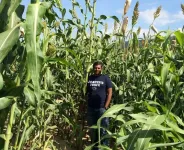(Press-News.org) With sorghum poised to become an important crop grown by Pennsylvania farmers, Penn State researchers, in a new study, tested more than 150 germplasm lines of the plant for resistance to a fungus likely to hamper its production.
Sorghum, a close relative to corn, is valuable for yielding human food, animal feed and biofuels. Perhaps its most notable attribute is that the grain it produces is gluten free. Drought resistant and needing a smaller amount of nutrients than corn to thrive, sorghum seems to be a crop that would do well in the Keystone State's climate in a warming world. But its susceptibility to fungal disease is problematic.
"In other locations where sorghum has been grown for a long time, it is attacked by a fungal pathogen that causes a disease called anthracnose leaf blight, which diminishes its yield," said study co-author Surinder Chopra, professor of maize genetics in the College of Agricultural Sciences. "We conducted a three-part experiment designed to evaluate the likelihood that anthracnose will be a problem with sorghum production in Pennsylvania, and what plants might resist the disease."
First, researchers carried out field surveys in 2011, 2012 and 2016 in six Pennsylvania locations to monitor the presence of the Colletotrichum fungus that causes anthracnose in commercial sorghum fields. They collected soil samples, plant samples and samples of the debris left by sorghum or corn, looking for the fungus at sites in Blair, Lancaster, Dauphin, Centre, Bedford and Lebanon counties.
Next, researchers grew 158 sorghum lines at Penn State's Russell E. Larson Agricultural Research Center at Rock Springs and tested them for vulnerability and resistance to the natural strains of anthracnose fungus. They obtained plant material for many of the sorghum lines from the International Crops Research Institute for the Semi-Arid Tropics, better known as ICRISAT, India.
Other sorghum lines came from varieties Chopra's research group has been breeding in plots at Rock Springs for years and are being tested for stress tolerance in another study. Still others came from sources such as the U.S. Department of Agriculture's Agricultural Research Service stations in Griffin, Georgia, Lincoln, Nebraska, and Lubbock, Texas; the Grain, Forage and Bioenergy Research Center, Texas A&M Agrilife Sorghum Breeding Program; and the National Plant Germplasm System.
Lastly, researchers conducted experiments in greenhouses on the University Park campus. They chose 35 sorghum lines that demonstrated resistance to the fungus in field trials and tested their responses after inoculating them with the pathogen. The team evaluated and scored those plants for the severity of anthracnose leaf blight that developed.
In findings recently published in Crop Science, Chopra and colleagues reported that the anthracnose leaf blight symptoms were observed on the older and senescent leaves in Pennsylvania. After evaluating, in field and greenhouse tests, the performance of the 158 experimental lines and commercial hybrids, the researchers noted that they discovered sources of resistance to anthracnose leaf blight.
"Many of those sorghum lines we tested had been improved in several states in the U.S. and in other parts of the world," Chopra said. "These should be useful in breeding programs targeted for Pennsylvania and for northeastern U.S. climatic conditions. Several lines received from ICRISAT showed the high level of resistance in the field."
The research was done in preparation for widespread cultivation of sorghum in Pennsylvania, at which time anthracnose leaf blight is expected to become a problem for farmers, Chopra explained.
"Our study is the first to investigate the frequency, diversity and distribution of Colletotrichum fungi species on sorghum in Pennsylvania, and the first to look for disease-tolerant strains that will grow best in the Northeast," he said. "Our findings will help develop better recommendations for sorghum growers so they can manage and proactively prevent the buildup of inoculum and resulting disease outbreaks."
INFORMATION:
Also involved in the research were Iffa Gaffoor, former postdoctoral scholar in the Department of Plant Science at Penn State, advised by Chopra; Germán Sandoya, Everglades Research and Education Center/Horticultural Sciences Department, University of Florida; Katia Xavier, Lisa Vaillancourt and Etta Nuckles, Department of Plant Pathology, University of Kentucky; and Srinivasa R Pinnamaneni, Sorghum Breeding Program, ICRISAT, Patancheru, India.
The U.S. Department of Agriculture's National Institute of Food and Agriculture and the Fundacion Alfonso Martin Escudero for postdoctoral research provided funding for this work.
The article 'The RNA Atlas expands the catalog of human non-coding RNAs', published today in Nature Biotechnology, is the result of more than five years of hard work to further unravel the complexity of the human transcriptome. Never before such a comprehensive effort was undertaken to characterize all RNA-molecules in human cells and tissues.
RNAs in all shapes and sizes
Our transcriptome is - analogous to our genome - the sum of all RNA molecules that are transcribed from the DNA strands that make up our genome. However, there's no 1-on-1 relationship with the latter. Firstly, each cell and tissue hasve a unique transcriptomes, with varying RNA production and compositions, including tissue-specific RNAs. Secondly, ...
Additive manufacturing offers an unprecedented level of design flexibility and expanded functionality, but the quality and process can drastically differ across production machines, according to Hui Yang, a professor of industrial engineering at Penn State. With applications in aerospace, health care and automotive industries with potential for mass customization, additive manufacturing needs quality management.
To address this concern, Yang and a team of researchers from Penn State, University of Nebraska--Lincoln and the National Institute of Standards and Technology (NIST) proposed the design, development and implementation of a new data-driven methodology for quality control in additive manufacturing. They published their work in the Proceedings ...
CAMBRIDGE, MA--Geothermal energy systems have the potential to power the world and become the leading technology for reducing greenhouse gas emissions if we can drill down far enough into the Earth to access the conditions necessary for economic viability and release the heat beneath our feet. END ...
SAN ANTONIO (June 17, 2021) -- Convalescent plasma therapy was associated with better survival in blood cancer patients hospitalized with COVID-19, especially in sicker patients. The findings by the COVID-19 and Cancer Consortium (CCC19) are newly published in the peer-reviewed journal JAMA Oncology.
The Mays Cancer Center, home to UT Health San Antonio MD Anderson, is part of the CCC19. The international consortium is composed of 124 medical centers and institutions in North and South America that conduct research to learn how COVID-19 affects cancer patients.
Dimpy Shah, MD, PhD, is an epidemiologist and assistant professor of population health sciences at The University of Texas Health ...
Forest fires have crept higher up mountains over the past few decades, scorching areas previously too wet to burn, according to researchers from McGill University. As wildfires advance uphill, a staggering 11% of all Western U.S. forests are now at risk.
"Climate change and drought conditions in the West are drying out high-elevation forests, making them particularly susceptible to blazes," says lead author Mohammad Reza Alizadeh, a PhD student at McGill University under the supervision of Professor Jan Adamowski. "This creates new dangers for mountain communities, with impacts on downstream water supplies and the plants and wildlife that call these forests home."
Climate warming has diminished 'flammability barrier'
In ...
If the genome is the recipe of life, base pairs are the individual ingredients listed. These chemical structures form DNA, and every living organism on Earth has just four. The specific arrangements of these four base pairs -- A, T, C, G -- make us who and what we are.
So it was a big surprise when Scripps Research scientists revealed in 2014 that they could introduce two new, unnatural base pairs (they called them X and Y for short) into the genetic code of living bacteria in the lab. It was like two never-seen-before ingredients tossed into the recipe, hypothetically expanding the variety of dishes a cell can whip up.
Researchers immediately saw the potential applications: With more control and selection, they ...
In a bid to find or refine laboratory research models for cancer that better compare with what happens in living people, Johns Hopkins Medicine scientists report they have developed a new computer-based technique showing that human cancer cells grown in culture dishes are the least genetically similar to their human sources.
The finding, they say, should help focus more resources on cancer research models such as genetically engineered mice and 3D balls of human tissue known as "tumoroids" to better evaluate human cancer biology and treatments, and the genetic errors ...
An algorithm designed by researchers from Carnegie Mellon University's Computational Biology Department and St. Petersburg State University in Russia could help scientists identify unknown molecules. The algorithm, called MolDiscovery, uses mass spectrometry data from molecules to predict the identity of unknown substances, telling scientists early in their research whether they have stumbled on something new or merely rediscovered something already known.
This development could save time and money in the search for new naturally occurring products that could be used in medicine.
"Scientists waste a lot of time isolating molecules that are already known, essentially rediscovering penicillin," said Hosein Mohimani, an assistant ...
Leesburg, VA, June 17, 2021--According to ARRS' American Journal of Roentgenology (AJR), a reduced dose of gadobutrol is non-inferior to 100%-standard dose of gadoterate for contrast-enhanced brain MRI.
"A 25% reduced gadobutrol dose demonstrated non-inferior efficacy versus standard dose gadoterate for contrast-enhanced brain MRI," corresponding author Jan Endrikat of Germany's University Medical School of Saarland elaborated, "warranting particular consideration in patients undergoing multiple contrast-enhanced examinations."
In this international, prospective, multicenter, open-label, crossover trial (LEADER-75), 141 patients (78 men, 63 women; mean age, 58.5 years) with known or suspected CNS pathology ...
Type 1 diabetes is a disorder in which the immune system inappropriately targets a class of cells in the pancreas known as β cells that produce the hormone insulin, which plays an important role in regulating bloodstream glucose levels and the metabolism of carbohydrates, lipids, and proteins. The loss of insulin causes a range of health problems for people with type 1 diabetes, and patients become dependent on insulin injections for their survival. Even with insulin therapy, people with type 1 diabetes have shortened lifespans and are at an elevated risk of developing myriad complications.
Previous studies have identified numerous genetic risk factors for type 1 diabetes. One notable finding is the importance of the HLA region, a part of the human ...


